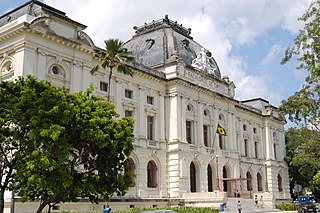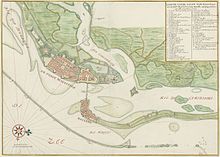
Recife is the state capital of Pernambuco, Brazil, on the northeastern Atlantic coast of South America. It is the largest urban area within both the North and the Northeast Region of Brazil. It is the largest city in Pernambuco state, and the fourth-largest urban area in all of Brazil, home to roughly 4,054,866 people including the adjacent suburbs; the metro population of the city of Recife was 1,653,461 in 2020. Recife was founded by the colonial Portuguese Empire in 1537, serving as the main harbor of the Captaincy of Pernambuco—known for its large-scale production of sugar cane. At one point, it was known as Mauritsstad, when it served as the capital city of the 17th century colony of New Holland of Dutch Brazil. Situated at the confluence of the Rivers Beberibe and Capibaribe, before they drain into the South Atlantic Ocean, Recife is a major seaport along the Brazilian Atlantic coast. Its name is an allusion to the stone reefs that are present offshore. Together with the urban presence of the Beberibe and Capibaribe Rivers and their tributaries, the many additional unique, small islands—and more than 50 bridges linking them throughout the city—create a distinct maritime or "riviera" atmosphere, leading to Recife being known as the "Venice of Brazil".

Pernambuco is a state of Brazil, located in the Northeast region of the country. With an estimated population of 9 million people as of 2022, making it seventh-most populous state of Brazil and with around 98,067.877 km2, being the 19th-largest in area among federative units of the country, it is the sixth-most densely populated with around 89 people per km2. Its capital and largest city, Recife, is one of the most important economic and urban hubs in the country. Based on 2019 estimates, the Recife Metropolitan Region is seventh-most populous in the country, and the second-largest in northeastern Brazil. In 2015, the state had 4.4% of the national population and produced 2.8% of the national gross domestic product (GDP).

Olinda is a historic city in Pernambuco, Brazil, in the Northeast Region. It is located on the country's northeastern Atlantic Ocean coast, in the Metropolitan Region of Recife, the state capital. It has a population of 393,115 people, covers 41.681 square kilometres (16.093 sq mi), and has a population density of 9,437 inhabitants per square kilometre (24,440/sq mi). It is noted as one of the best-preserved colonial cities in Brazil and has been inhabited since 1535.

Camaragibe is a city in northeastern Brazil, in the State of Pernambuco. It lies near Recife at 8.00° South, 35.04° West.

John Maurice of Nassau, called "the Brazilian" for his fruitful period as governor of Dutch Brazil, was Count and Prince of Nassau-Siegen. He served as Herrenmeister of the Order of Saint John from 1652 until his death in 1679.

The mangue bit or manguebeat movement is a cultural movement created circa 1991 in the city of Recife in Northeast Brazil in reaction to the cultural and economic stagnation of the city. The movement largely focuses on music, but it has its own fashion and slang, and encompasses aspects of visual art. It mixes regional rhythms of Brazilian Northeast, such as maracatu, frevo, coco and forró, with rock, soul, raggamuffin, hip hop, funk and electronic music.

Sport Club do Recife, known as Sport Recife or Sport, is a Brazilian sports club, located in the city of Recife, in the Brazilian state of Pernambuco. Founded in 1905, the club currently plays in Série B. In football, the club has won six CBD/CBF titles, including three national and three regional. Its greatest achievements are winning the 1987 Brazilian Championship and 2008 Copa do Brasil. In addition to professional football, the club also participates in women's football and Olympic sports, such as rowing, swimming, hockey, basketball, futsal, volleyball, table tennis, taekwondo, judo and athletics.

In Brazil, public holidays may be legislated at the federal, statewide and municipal levels. Most holidays are observed nationwide.

The Second Battle of Guararapes was the second and decisive battle in a conflict called the Insurrection of Pernambuco, between Dutch and Portuguese forces in February 1649 at Jaboatão dos Guararapes in Pernambuco. The defeat convinced the Dutch "that the Portuguese were formidable opponents, something which they had hitherto refused to concede." The Dutch still retained a presence in Brazil until 1654 and a treaty was signed in 1661.

Cabrobó is a city in the Brazilian state of Pernambuco, 536 km away from the state's capital, Recife. The city is located just to the north of a section of the São Francisco River that contains many archipelagos.

Dutch Brazil, also known as New Holland, was a colony of the Dutch Republic in the northeastern portion of modern-day Brazil, controlled from 1630 to 1654 during Dutch colonization of the Americas. The main cities of the colony were the capital Mauritsstad, Frederikstadt, Nieuw Amsterdam (Natal), Saint Louis, São Cristóvão, Fort Schoonenborch (Fortaleza), Sirinhaém, and Olinda.

Jaboatão dos Guararapes is a city in the state of Pernambuco, Brazil. It is a part of the Recife metro area. The population was 706,867 according to the Brazilian Institute of Geography and Statistics (IBGE) in 2020, making it the second most-populous city in the state of Pernambuco and the 27th in Brazil, ahead of major Brazilian state capitals such as Cuiabá and Aracaju. The city is a very important industrial center, hosting companies like Unilever and Coca-Cola. It is bordered by Recife in the north, Cabo de Santo Agostinho on the south, and Mangue forests to the west in Moreno.

The Recife broad-nosed bat, is a species of bat from South America. It is named for the city of Recife in Brazil, where it was first recorded by Oldfield Thomas in 1901.

Francisco Brennand, or Francisco de Paula de Almeida Brennand,, was a Brazilian painter and sculptor, best known for his work in ceramics.

The Recife School of Law, is the law school of the Federal University of Pernambuco, it is located in Recife, Pernambuco, Brazil.

Água Preta is a Brazilian municipality (city) in the state of Pernambuco. It covers 533.33 km2 (205.92 sq mi), and has a population of 37,082 with a population density of 62.05 inhabitants per square kilometer.
Carlos Roberto Cavalcanti de Albuquerque, known as Robertinho do Recife, is a Brazilian guitarist, record producer, composer born in the city of Recife, Brazil. His first contact with the guitar was at the age of 10. After he was run over by a car, he had to stay long periods of time at home and had to watch a lot of TV. In one of these TV programs he met the Beatles and fell in love with the guitar. He got his first guitar as a gift from his grandfather. At the age of 12 he was already playing with bands in Recife. He had very good technique and later was invited to play with bands like: Watch Pocket, Chicago and Quiet Riot. He played a little of everything: from music for children, to heavy metal and neoclassical. At the end of the 1980s he played with the Brazilian band Yahoo, when they played a cover of "Love Bites", a song from the British band Def Leppard. He is currently working as a music producer in his own studio in Rio de Janeiro.

Xexéu is a city in Pernambuco, Brazil. It is located in Zona da mata Pernambucana 143 km (89 mi) from the state capital Recife. It was first municipality in Latin America to use ecological asphalt.

The Recapture of Recife was a military engagement between the Portuguese forces under Francisco Barreto de Meneses and the Dutch forces of Captain Walter Van Loo. After the Dutch defeats at Guararapes, their surviving men, as well as other garrisons of New Holland, joined in the area of Recife (Mauritsstad) in order to make a last stand. However, after fierce fighting, the Portuguese victoriously entered the city and the remaining Dutch were ousted from Brazil.

The Dutch invasions in Brazil, ordered by the Dutch West India Company (WIC), occurred during the 17th century.




















